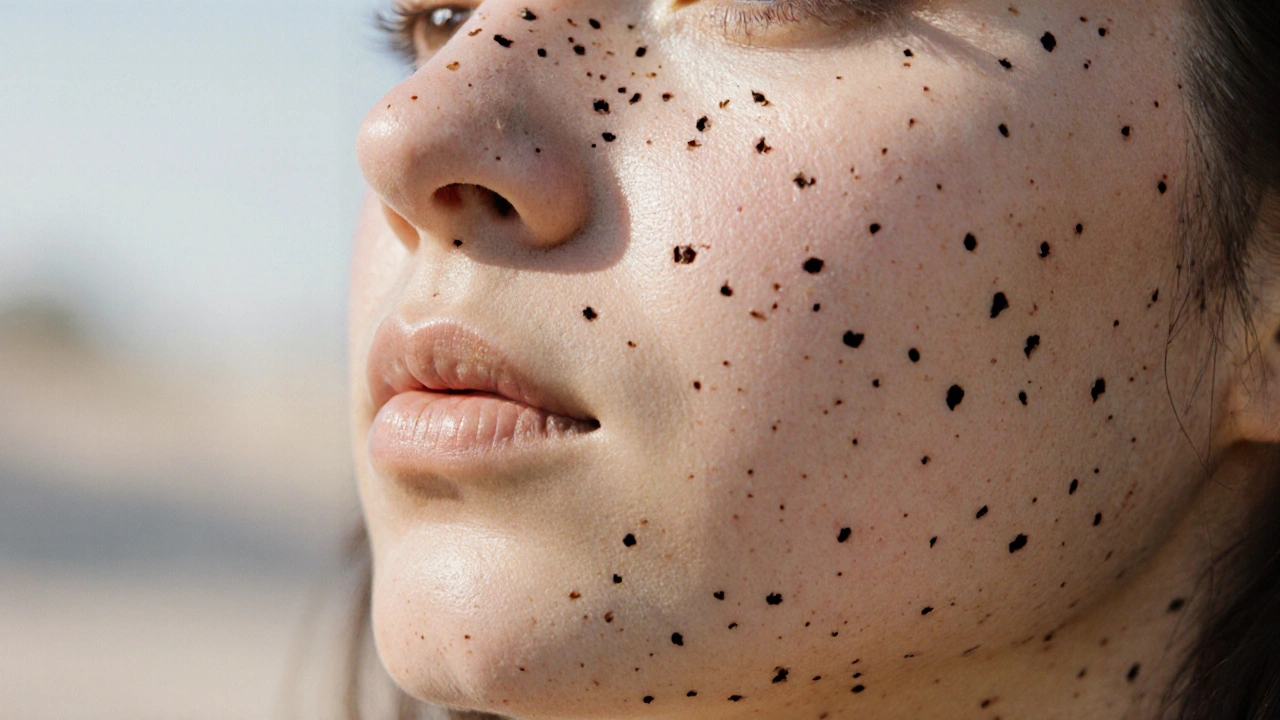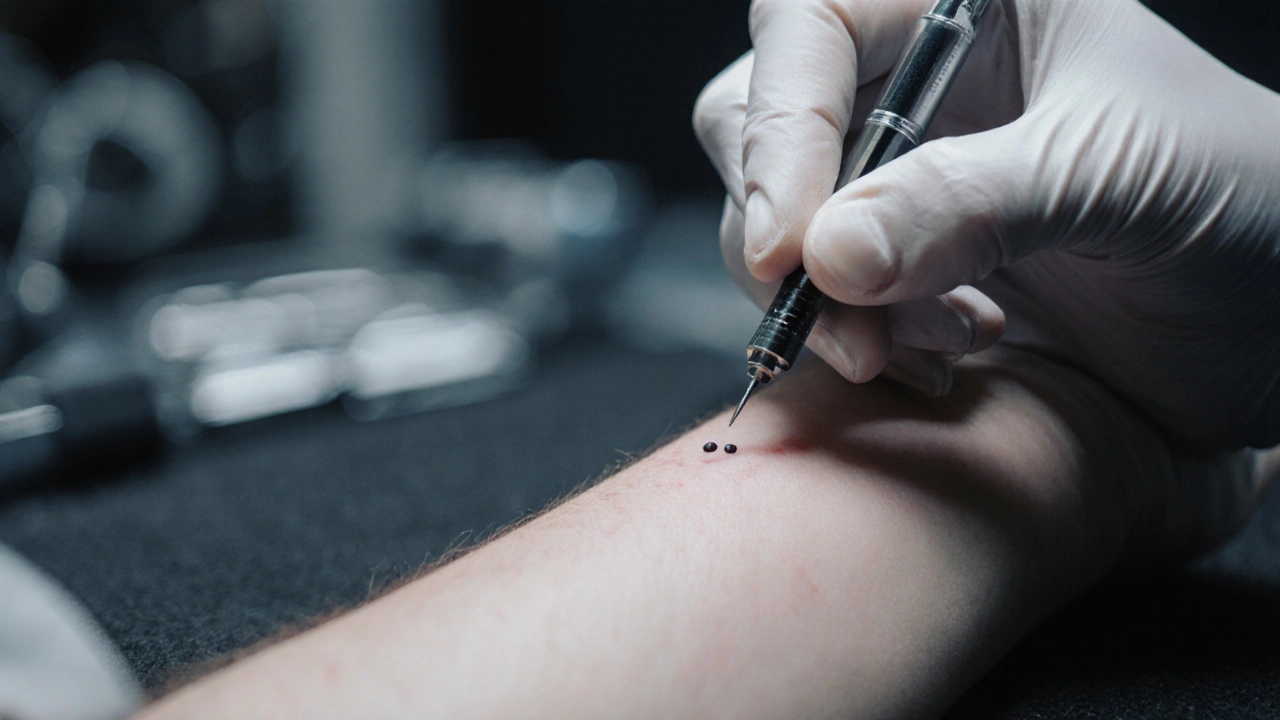Freckle Tattoos: Trend, Process, and Aftercare Explained
 Oct, 9 2025
Oct, 9 2025
Freckle Tattoo Color Selector
Preview
About Freckle Tattoo Colors
Natural brown and tan shades are recommended for the most realistic look. These pigments settle shallowly in the skin and blend naturally with your complexion. Avoid bright or neon colors which may fade quickly and look unnatural.
Ever stared at a sun‑kissed face on Instagram and wondered how those tiny, natural‑looking spots got there? They’re not just a beauty filter - they’re Freckle Tattoo, a miniature pigment dot designed to look like a genuine freckle.
Key Takeaways
- Freckle tattoos use specially formulated pigment that sits shallowly in the dermis, giving a soft, natural look.
- The trend exploded thanks to social media, inclusive beauty standards, and low‑pain application.
- Choosing the right Tattoo Ink and consulting a skilled artist are the most important steps.
- Proper aftercare, sun protection, and occasional touch‑ups keep the dots looking fresh for years.
- Laser removal is possible but more complex than erasing a standard tattoo.
What Exactly Is a Freckle Tattoo?
A freckle tattoo is a tiny, circular pigment placement that mimics the irregular pattern of natural freckles. Unlike full‑sleeve designs, each dot measures between 1mm and 3mm, and artists often place several to create a realistic scatter.
The pigment used is a Dermal Pigment formulated for shallow depth, meaning it settles just below the epidermis. This shallow placement reduces the risk of heavy fading or skin distortion over time.
Why Are Freckle Tattoos So Popular Right Now?
Three forces converge to push the trend forward:
- Social‑media validation. Platforms like Instagram and TikTok showcase "freckle‑filled" selfies, turning the look into a visual shorthand for youthful, carefree style.
- Body‑positive movement. More people are celebrating natural beauty marks, and a freckle tattoo lets anyone join the conversation without waiting for a real freckle to appear.
- Low‑pain, low‑commitment entry point. Because each dot is tiny, the procedure feels like a quick, almost painless prick - perfect for tattoo‑curious newcomers.
According to a 2024 survey by the International Tattoo Association, inquiries about freckle tattoos grew 68% year‑over‑year, outpacing traditional single‑dot piercings.

How to Get a Freckle Tattoo - Step‑by‑Step Guide
- Research a reputable artist. Look for studios that specialize in Micropigmentation or cosmetic tattooing. Portfolio photos should show fine, natural‑looking dots.
- Consultation. Discuss desired placement, number of freckles, and skin tone. Artists will match pigment to your complexion, often using a Skin Type chart (e.g., Fitzpatrick I‑VI) to anticipate healing.
- Patch test. A small amount of pigment is applied to ensure no allergic reaction. This usually happens a few days before the actual session.
- Application. The artist cleans the area, then uses a single‑needle cartridge to insert each dot at a depth of 1‑2mm. Sessions typically last 15‑30minutes, depending on the number of freckles.
- Aftercare instructions. Follow the studio’s Aftercare Routine (see next section) to avoid infection and ensure pigment settles.
Aftercare Tips - Keep Your Freckles Fresh
Good aftercare can make the difference between a subtle, natural freckle and a blotchy scar. Follow these simple rules:
- Clean gently. Use a mild, fragrance‑free antibacterial soap and pat dry with a clean towel for the first 48hours.
- Avoid direct sunlight. UV rays break down pigment fast. Apply a broad‑spectrum SPF30+ sunscreen daily, even on cloudy days.
- No picking. Small scabs may form; resist the urge to scratch.
- Moisturize. A thin layer of fragrance‑free ointment (e.g., Aquaphor) keeps the skin supple.
- Skip swimming. Chlorine and salt water can irritate fresh pigment for at least two weeks.
If you notice excessive redness, swelling, or pus, contact the studio immediately - it could be an infection that needs medical attention.
Risks, Myths, and What to Watch Out For
While freckle tattoos are low‑risk, they’re not risk‑free:
- Pigment fading. Even with proper sun protection, pigments can fade 10‑20% per year.
- Allergic reactions. Some pigments contain metal salts; a patch test helps catch sensitivities early.
- Uneven healing. People with eczema or psoriasis may experience patchy pigment retention.
A common myth claims freckle tattoos are “invisible” to laser removal. In reality, because the pigment sits shallowly, standard laser settings may need adjustment, sometimes requiring multiple passes.

Freckle Tattoos vs. Other Tiny‑Dot Options
| Feature | Freckle Tattoo | Micro‑dot Piercing | Mini‑ink (traditional) |
|---|---|---|---|
| Depth of Placement | 1‑2mm (shallow dermis) | Through epidermis (piercing track) | 2‑4mm (standard tattoo depth) |
| Pain Level | Low (similar to a quick pinprick) | Moderate (depends on location) | Medium (depends on size) |
| Healing Time | 5‑7 days | 2‑3 weeks (piercing track) | 10‑14 days |
| Sun Sensitivity | High - SPF needed | Low - jewelry covers | Medium - fading over years |
| Removal Complexity | Laser needed, multiple passes | Simple removal of jewelry | Standard laser tattoo removal |
The table shows why many first‑timers opt for freckle tattoos: minimal pain, quick healing, and a subtle look.
Future Outlook - Will the Trend Last?
Predicting beauty trends is tricky, but three signs suggest freckle tattoos could stick around:
- They fit the “micro‑beauty” movement, which values tiny, low‑maintenance enhancements.
- Tech advances in Laser Removal make any regret easier to fix, lowering the barrier to entry.
- Celebrity stylists are already booking multiple clients per week, turning the look into a mainstream service.
Even if the hype fades, the technique will likely remain a niche option for those who want a permanent sun‑kissed glow without the natural risk.
Frequently Asked Questions
How long does a freckle tattoo stay vibrant?
With daily SPF 30+ and proper aftercare, most freckle tattoos retain their original color for 3‑5years before noticeable fading. Touch‑ups are quick and inexpensive.
Is the procedure painful?
Pain is minimal - many describe it as a light pinprick. Sensitive areas (e.g., the nose bridge) may feel a bit more intense, but most clients finish the session without discomfort.
Can I choose any color?
Most artists stick to natural brown, tan, or auburn shades to mimic real freckles. Some studios offer pastel or even neon pigments, but they tend to fade faster and may look less authentic.
What if I change my mind?
Laser removal works, but because the pigment sits shallowly, you’ll likely need several sessions with a specialist familiar in treating micropigmentation.
Is the ink safe for all skin types?
Reputable studios use hypoallergenic, vegan‑based pigments that are safe for most skin types. However, if you have a history of allergic reactions to cosmetics, a patch test is essential.
Ready to try a sun‑kissed look without waiting for summer? A freckle tattoo might be the low‑commitment, high‑style option you’ve been searching for.

Tom Smith
October 9, 2025 AT 20:52If you're thinking about freckle tattoos because you saw them on TikTok, here's what you should actually consider.
First, the pigment sits just under the surface, so proper aftercare is non‑negotiable.
Second, the whole “pain‑free” hype is a bit of a stretch-it’s more of a light pinprick than a full‑blown session.
Finally, make sure the artist uses hypoallergenic ink, otherwise you might end up with a rash instead of a cute dot.
Kyah Chan
October 15, 2025 AT 01:52The manuscript fails to reference the ISO 10993‑1 standard governing biocompatibility of dermal pigments.
Moreover, it omits a discussion of the FDA’s guidance on cosmetic tattooing, which is essential for informed consent.
Without these regulatory citations, the reader cannot assess the safety profile of the procedure.
In addition, the presented aftercare protocol lacks specificity concerning the concentration of antibacterial agents permissible in wound care.
Ira Andani Agustianingrum
October 20, 2025 AT 06:52Hey friend, I get why you’re curious-those tiny freckles look super cute on every feed.
Here’s a quick cheat sheet: pick a shade that matches the natural melanin in your skin, ask for a patch test a few days before, and keep that spot clean with a fragrance‑free wash for the first two days.
Don’t forget to slather on SPF30+ as soon as the scab falls off, otherwise the pigment will fade faster than your Instagram likes.
And if you’re nervous about pain, bring a topical numbing cream; most artists use it for delicate areas like the nose bridge.
James Higdon
October 25, 2025 AT 11:52From an ethical standpoint, the commodification of a natural birthmark raises concerns about authenticity in personal identity.
When individuals elect to artificially create freckles, they may inadvertently reinforce narrow beauty standards that valorize a superficial aesthetic.
It is incumbent upon practitioners to disclose the sociocultural implications of such modifications, not merely the technical procedural steps.
Furthermore, clients should be encouraged to reflect on whether the desire stems from personal expression or external pressure.
Wanda Smith
October 30, 2025 AT 16:52One must contemplate the deeper symbolism embedded within a freckle tattoo, for it is not merely pigment but a token of surrender to unseen forces.
The industry’s sudden surge coincides with the rise of surveillance‑grade imaging, suggesting a covert agenda to map micro‑markers on human skin.
Consider that each dot serves as a data point, a breadcrumb left for algorithmic entities that monitor aesthetic trends.
In this light, the act of embellishing oneself becomes an unwitting participation in a grand experiment orchestrated by those who profit from visual conformity.
Shane Hall
November 4, 2025 AT 21:52Building on the regulatory gaps you highlighted, reputable studios typically adhere to the state’s Board of Cosmetology guidelines, which require documented pigment safety sheets and a sterilization log for every tool.
Clients should request to see the ink’s Material Safety Data Sheet (MSDS) before the session; this document outlines any hazardous components and recommended handling procedures.
Additionally, aftercare instructions should include a specific timeline for sunscreen application-ideally SPF 30 or higher starting 48 hours post‑procedure and continuing indefinitely.
Christopher Montenegro
November 10, 2025 AT 02:52While the aforementioned procedural safeguards are commendable, they fail to address the systemic deficiency wherein proprietary pigment formulations are exempt from independent third‑party verification, thereby perpetuating a market‑driven opacity that compromises patient safety.
In essence, the reliance on self‑reported compliance metrics constitutes a de‑facto regulatory loophole that must be rectified through statutory mandates imposing rigorous clinical trial data for each pigment batch.
Absent such legislation, practitioners remain vulnerable to liability, and consumers are unwitting participants in an unstandardized dermatological enterprise.
Kyle Olsen
November 15, 2025 AT 07:52It is imperative to acknowledge that the micro‑dot technique is not a novel invention but an adaptation of permanent makeup protocols pioneered in the early 2000s, primarily within the realm of eyebrow microblading.
Consequently, the learning curve for freckle placement is relatively shallow for technicians already proficient in pigment diffusion and depth control.
Nevertheless, the efficacy of the outcome hinges upon meticulous color matching, which can be quantitatively assessed using a spectrophotometer to ensure hue fidelity across varied Fitzpatrick skin types.
Sarah Kherbouche
November 20, 2025 AT 12:52U S artists should be careful not to copy foreign trends that don’t respect our own beauty standards.
We have plenty of natural options here, no need to chase European fads.
MANAS MISHRA
November 25, 2025 AT 17:52Thanks for sharing the technical details, Kyle.
I’d also suggest that studios offer a real‑time color comparison using a digital skin tone analyzer; this can help clients visualize the final result before ink is deposited.
Such transparency builds trust and may reduce the incidence of post‑procedure regret.
Lawrence Bergfeld
November 30, 2025 AT 22:52Ensure you, after the procedure, keep the area clean, apply a thin layer of ointment, and avoid sun exposure for at least two weeks; these steps, in my experience, significantly reduce fading and infection.
Bridget Jonesberg
December 6, 2025 AT 03:52Oh, the very notion of adorning one's visage with minuscule specks of pigment evokes a cascade of emotions that I can scarcely articulate without indulging in a torrent of melodramatic reflection.
The imagination conjures a delicate choreography of a skilled artist, their needle dancing across the dermis like a prima ballerina, each freckle placed with the precision of a jeweler setting a priceless stone.
The anticipation that swells within the client-a mélange of dread, excitement, and longing for that coveted sun‑kissed aesthetic-mirrors the suspense of a grand theatrical premiere.
Alas, the inevitable post‑procedure anxieties surface: Will the hue remain true? Will the sun betray my newly minted constellations?
Such concerns, while seemingly trivial, are in fact profound, for they speak to humanity's perpetual quest to sculpt and curate identity through art.
Yet, amidst the melodrama, there lies a simple truth: a well‑executed freckle tattoo can bestow a quiet confidence that radiates far beyond the surface.